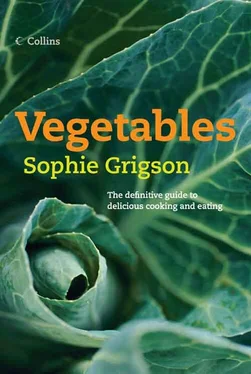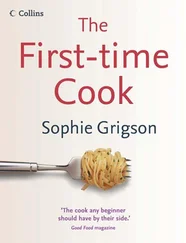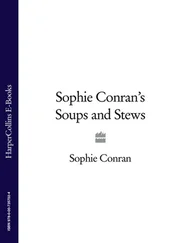Vegetables
Sophie Grigson

For Florrie and Sid, of course
Cover Page
Title Page Vegetables Sophie Grigson
Dedication For Florrie and Sid, of course
Introduction
Author’s acknowledgements
Roots
Beetroot
Carrots
Celeriac
Chervil root
Hamburg parsley
Jerusalem artichokes
Jicama
Kumara
Oca
Parsnips
Potatoes
Radishes
Salsify and Scorzonera
Swede
Sweet potatoes
Turnips
Yams
Shoots and stems
Asparagus Beansprouts Cardoons Celery Fennel Globe artichokes Kohlrabi Samphire Wild asparagus
Beansprouts
Cardoons
Celery
Fennel
Globe artichokes
Kohlrabi
Samphire
Wild asparagus
Fruits
Aubergine
Avocado
Bell peppers
Okra
Tomatoes
Squashes
Courgettes
Cucumbers
Marrows
Summer squashes
Winter squashes
Pods and seeds
Broad beans
Edamame
Green beans and wax beans
Mangetouts and sugarsnaps
Peas and pea shoots
Runner beans
Shelling beans (borlotti, flageolet and cannellini)
Sweetcorn
Onion family
Garlic
Leeks with lentils, chorizo and eggs
Petit pot-au-feu
Onions
Shallots
Spring onions
Wild garlic
Brassicas
Broccoli, calabrese
Broccoli, sprouting
Brussels sprouts
Cabbage
Cauliflower
Red cabbage
Green and leafy
Curly kale and Cavolo nero
Pak choi
Spinach
Spring greens
Swiss chard
Salad leaves
Chicory
Chinese cabbage
Lettuces
Purslane
Radicchio
Rocket
Sorrel
Watercress and Land cress
Index
Copyright
About the Publisher
I have no choice but to make this introduction relatively short. I’ve used up my space allowance several times over already, and the book has grown royally in length since its original inception. The trouble with writing about vegetables is that there are just so many, so much to say about each one, so many enticing ways to prepare them. This is also the joy of writing about them and more importantly of cooking and eating them.
When I compiled my original list of vegetables that I wanted to include in this book, I decided to concentrate on those that could be bought relatively easily in this country, with just a handful of exceptional rarities (such as chervil root or wild asparagus) thrown in for good measure. The original 60 vegetables have increased to over 70, ranging from the familiarity of the carrot or potato, to the more unexpected taste of oca or jicama. And still I have not shoehorned them all into these pages. Devotees of Chinese arrowheads or waterchestnuts, Indian tindoori or drumsticks or bitter gourds will be disappointed. My daughter complained that there were no recipes for palm hearts, and remains barely mollified by my excuse that I’ve only once bought them fresh, in Spain, and canned vegetables have no place on these pages.
Vegetables have long been something of a passion of mine. This is my second book on vegetables, coming over a decade after the first. I’m still learning about them, coming across new ones, delighting in new and old ways of cooking homely vegetables. I remain fascinated by their differences, their similarities, the way they take starring role, or blend comfortably into the chorus, the way they contrast, the way they add subtlety, the wonderful colours, the rich earthy tones, the sweetness and the textures, the forms, the connection with the land we live in, or with the magic of foreign worlds. I like the notion that the onion is virtually ubiquitous, that other cooks all over the world chop them and fry them just as I do, I love the exoticness of oca, so strange and new in Europe, but as old as the hills of the Andes where they are used without a second thought. Even familiar territory harbours magic discoveries – like the white sprouting broccoli of Leicestershire, or the dramatic purple carrots of Mallorca.
To make the book easier to use (and write) I’ve grouped vegetables together with the cook in mind. This may occasionally make botanists blench, and from them I beg indulgence. To me it makes more sense to slot beansprouts alongside asparagus and cardoons in the ‘shoots and stems’ section, than to keep them with beans and peas. Globe artichokes caused endless arguments, but in the end we kept them next to cardoons to which they are so closely related, even though no-one could ever argue that they are either shoot or stem.
One repetitive refrain runs through the following pages. With almost all vegetables, freshness makes a marked difference in flavour. With some it is more apparent than others. Newly picked spring greens are sensational, for instance, as are peas eaten straight from the pod out in the vegetable garden or allotment where they are grown. These are the kind of simple pleasures we should all have access to. Unfortunately so many of the vegetables sold in our shops have been held in storage for too long, or have been flown so far, that they have lost their brand new sparkle. They will still be in notionally good condition, but no longer in their prime.
This is why I like to buy locally grown vegetables when I can. If they are organic, so much the better. I’m no puritan – I eat cherry tomatoes in the middle of winter from time to time because I can’t bear the thought of going totally without fresh tomatoes for nine months of the year. I regularly forget which day of the month my local farmers’ markets fall on, but when I do get it right, both I and the environment around me reap the benefits. The more we support our local producers, the more opportunities there will be to buy locally grown crops and the more choice we will have.
Above all, however, the message of this book is to make the most of the incredible richness of the vegetable world. This is no health manual, but we all know that vegetables are good for us and we should be eating more of them. It’s not difficult if you give them a chance. Buy widely; choose wisely; cook exuberantly.
Sophie Grigson
Author’s acknowledgements
My initial encounters with vegetables were, without exception, positive, thanks to my mother, the late Jane Grigson, who cooked them with care and love. I have her to thank for making vegetable-eating a pleasure right from the start, and for encouraging me to experiment with both familiar and new vegetables in later years. More recently, the regular weekly box of vegetables from Riverford Organics has shown me what an extraordinary difference genuine freshness makes to even the most pedestrian vegetables.
I would also like to acknowledge the debt I owe to so many of my friends, who have put up with me moaning about how long it has taken to pen this book, and above all to my editor, Denise Bates, and all of her team at HarperCollins, for their extraordinary patience and forbearance. The wonderful Susan Fleming has fitted copy-editing around the piecemeal delivery of the various sections of the book without a murmur of annoyance, at least in my hearing.
Once again I have been lucky enough to work with William Shaw, one of my favourite photographers (despite his appalling jokes), backed up by a wizard team consisting of the blessed Sam Squire on food and the long-suffering Rosie Dearden on styling – a real diamond, even though she doesn’t like cheese. Weird.
A big thank you to Zoltan and the cheery gang that run the coffee machine at Esporta in Oxford, which is where I retreat to write in relative peace. Annabel Hartog and Leslie Ball have helped me test recipes at home, while Sarah and Jennine have kept house, children and admin running smoothly. Last, but by no means least, a big thank you to the two most important people in my life, Florrie and Sid, who make me laugh, shout, get up in the morning, listen to Radio 1, and question almost every assumption I’ve ever made. They are also pretty good at eating vegetables. What more could a mother hope for?
Читать дальше













